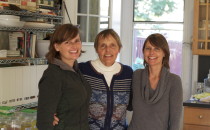Fostering a “Creator’s Mindset” for Your Child
A Guest Blog by Omowale Casselle, co-founder of Digital Adventures which prepares the inventors and innovators of tomorrow by offering computer coding classes, digital technology camps, and makers workshops for kids.
“The best way to predict the future is to invent it” – Alan Kay, Computer Scientist
While there are some who are busy imagining how the world might become a better place. There are others who are actively engaged in the creative process of building innovative solutions to make a dent in the universe – turning their dreams into reality. The modern generation has witnessed innovative hardware (iPhone, iPad) & software (Tesla autopilot) projects come to life right before our eyes from some of the most well know inventors: Bill Gates, Grace Hopper, Elon Musk, Shirley Jackson or Steve Jobs. Historically, we have always been drawn to these who develop the inventions that gain widespread adoption. As the next generation prepares for the automation economy, their invention platform will be technological. While learning to program computers is one skill they will need to have in their toolbox, there is also a need to more broadly develop the creator’s mindset. So, what are some of the key things kids can explore now so they can help us solve the really difficult problems going forward?
Build small projects before you invent big things
It is often seductive to read stories about the lone inventor spending years toiling away in her workshop before heroically inventing the next big thing. In reality, it is often an iterative process that yields the truly groundbreaking innovations. So, instead of your child thinking they have one shot to invent something new, have them focus on successfully building a multitude of small projects. As they become more comfortable and confident with the product development process, they will begin to understand the boundary conditions of problem statements much better and will start to aggregate their knowledge into solutions that may have a big impact. Even the most popular websites in the world look very different now than when they were 1st launched. One cool tool that you can use to see the evolution of websites and illustrate to your children the iterative development process is the Internet WayBack Machine. Go check out Facebook in 2006 or Apple in 1997.
Embrace failure as a learning experience
In the process of developing the lightbulb, Thomas Edison famously remarked, “I have not failed 10,000 times. I have not failed once. I have succeeded in proving that those 10,000 ways will not work. When I have eliminated the ways that will not work, I will find the way that will work.” In essence, Edison is communicating a fundamental creator belief – failure only occurs if you didn’t learn anything from the experiment. So, while it feels great to succeed the 1st time out of the gate, it is unlikely that you are truly developing an innovative solution if it can be discovered so easily. Instead, the successful inventor will have to try many different approaches and experiment with many different solutions before she finds something that works.
Identify difficult problems
There are a multitude of problems that we face on a daily basis. Some are mildly irritating and some are what venture capital investors refer to as ‘bleeding neck problems’. As you can imagine, when you develop solutions to truly difficult problems, you are likely making the world a much better place in the process. One of the best ways to truly understand a difficult problem is to ask potential customers if they first understand the problem you are trying to solve (i.e., have they struggled with this themselves?). After you go through a customer discovery process enough times, you can start to get a sense for which problems are truly individual in nature and which seem to impact large groups of people.
Don’t underestimate cross-disciplinary learning
Often-times there are great benefits in specialization. You want your cardiologist to eat, drink, read and sleep on all things related to the proper function of the heart. Similarly, those who become truly great at their profession accomplish this peak performance through intense focus. However, that does not mean that cross-disciplinary learning is not important. For example, Kobe Bryant said that his basketball footwork was developed through his experience playing soccer as a child. Similarly, Steve Jobs developed expertise in visualization and design through a calligraphy course that he dropped in on in college. Were he to have exclusively focused on technology to the exclusion of everything else, he may not have led the invention & widespread consumer adoption of beautifully designed hardware and software products.
Develop their critical design eye
Some of the best products (Tesla, iPhone) on the market today have a high level of design aesthetic. These products are often described as beautiful or magic. And, while it’s great to appreciate the result, it is important to acknowledge that there is a team of designers who has helped make these products great. To begin to develop your child’s design muscle, have them point out what they like and don’t like about products. Do they appreciate the color scheme used? Or, do they think a different color palette would make the product more enjoyable to use? Do they like the way the buttons or touchscreen in your vehicle are displayed? Or, do they think that there is display that would make it easier to change the radio station or turn on the air conditioning? At home, do they think the controls on the stove are easy to understand? What would they do different? As your child gains more familiarity with the impact of design on product development, they will get a clear sense of their likes/dislikes. The crucial exercise is to push them on what they would do differently or how would they make it better.
As we keep an eye towards the future, it is exciting to think that the next generation of innovators and inventors are in elementary, middle and high school. Given the numerous opportunities to develop solutions to really difficult problems, it is awesome to imagine what these kids might invent to make the world a better place.
Want to foster your child’s creator’s mindset? Try a FREE class at Digital Adventures North Shore or Lincoln Park location with promo code: MEEZCODER
About the author:
Omowale Casselle is the co-founder of Digital Adventures. He is a passionate believer in the potential of the next generation to impact positive change in the world. His company, Digital Adventures , prepares the inventors and innovators of tomorrow by offering computer coding classes, digital technology camps, and makers workshops for kids in Pre-K-12th grade on a variety of digital technology topics including 3D Printing, Visual Programming, Video Game Design, Robotics & Minecraft Modding. Their programs are project-based and generate either a digital or physical artifact at the conclusion of each session. Check out their Facebook (5 Stars) & Yelp (5 Stars) reviews to see what other parents think about their coding for kids programs. To get more information, visit their website or give them a call: 844-KID-CODE (543-2633).


Leave a Comment